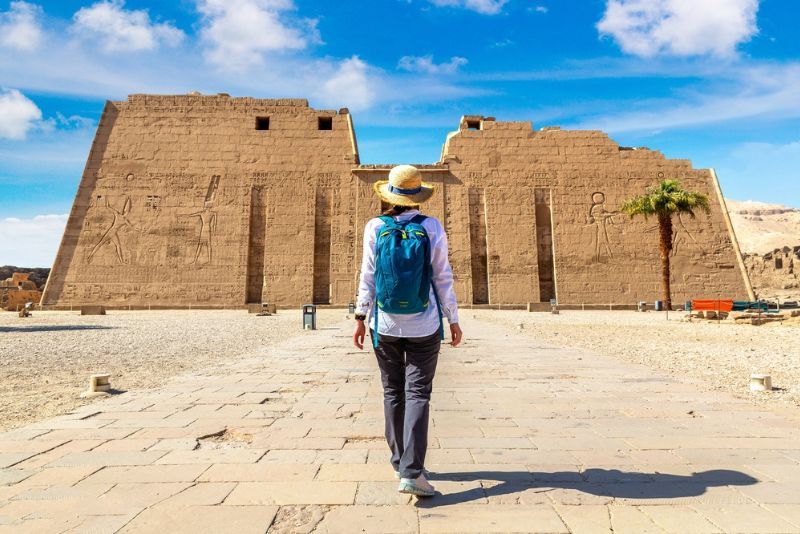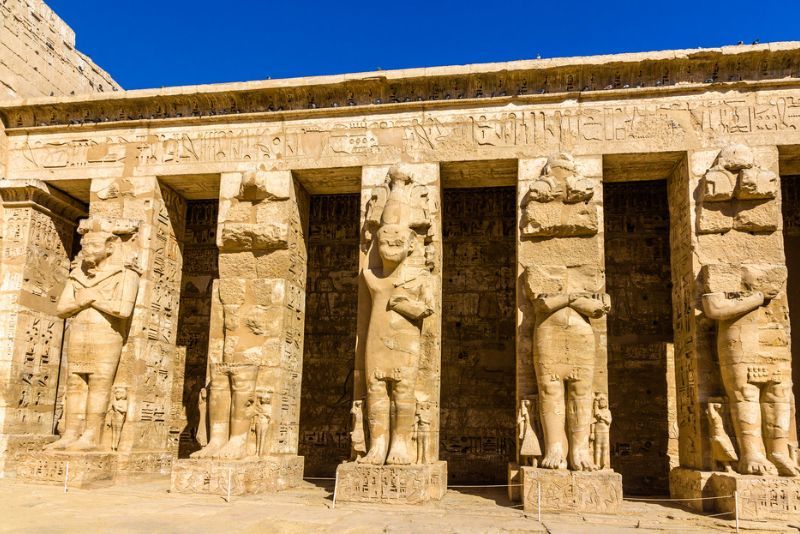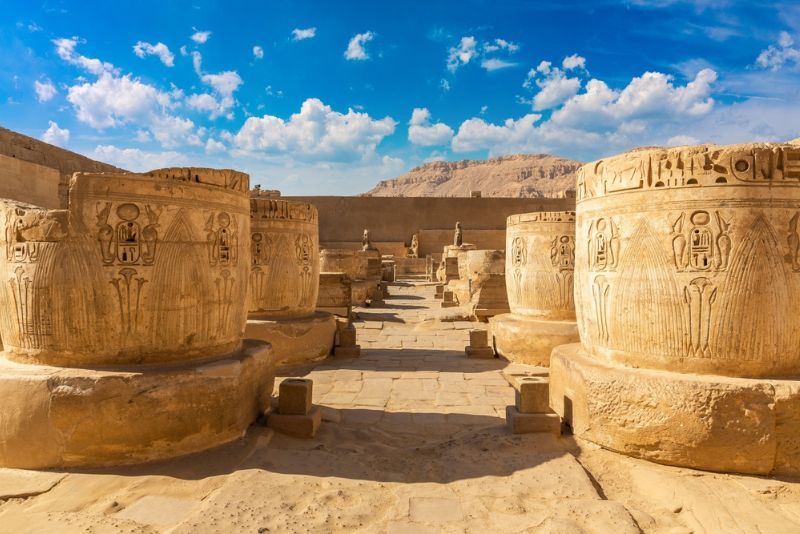
Habu Temple: Tickets and Tours
The Medinet Habu Temple is considered one of the most impressive sights to see while visiting the city of Luxor in Egypt. The imposing structure was constructed by the last great pharaoh of Egypt, Ramesses III, in the 1100s B.C. and has miraculously stood the test of time. The breathtaking monument is covered in ancient artwork, including depictions of the pharaoh. Habu Temple tickets and tours are a great way to learn about one of the most important religious centers of the country and how its creator led to the fall of the pharaohs in Egypt.
Read Full Guide
Checking Musement... (0/24 providers)
















































The Medinet Habu Temple is considered one of the most impressive sights to see while visiting the city of Luxor in Egypt. The imposing structure was constructed by the last great pharaoh of Egypt, Ramesses III, in the 1100s B.C. and has miraculously stood the test of time.
The breathtaking monument is covered in ancient artwork, including depictions of the pharaoh. Habu Temple tickets and tours are a great way to learn about one of the most important religious centers of the country and how its creator led to the fall of the pharaohs in Egypt.

Here's all you need to know about Habu Temple, one of the most exciting attractions in Luxor.
How much do Habu Temple tickets cost?
Tickets to enter the Habu Temple cost E£100 (about €3) per person.
Should you book in advance?
Book skip-the-line tickets or a tour of Habu Temple in advance to avoid crowds while at the monument and to learn fascinating information about the historical destination from an expert guide.
What are the best Habu Temple tours?
Private tour of Habu Temple
Explore Luxor’s Medinet Habu Temple on a private tour along the West Bank of the Nile River. This 4-hour excursion begins with an early morning pickup at your hotel in Luxor in a private air-conditioned vehicle. From there, you’ll begin the journey to Habu Temple.
The monument itself is located in an archaeological zone beneath the Theban Hills. The 150-meter-long landmark is considered the Mortuary Temple of Ramesses II and contains other holy sanctuaries, including the Temple of Amun from the 18th Dynasty built by Thutmose III and Queen Hatshepsut.
Private tours of Habu Temple typically cost US$40 to US$60 per person, with more expensive tours covering additional attractions.
Are there any combined tickets or tours including Habu Temple and other attractions?

Habu Temple plus Luxor East and West Banks
This combination tour of Luxor visits both the East bank and West bank of the Nile River, including stops at Habu Temple, the Valley of the Kings, Karnak and more. This excursion begins with a morning pickup in an air-conditioned car and 45-minute drive to the West Bank.
You’ll start in the Valley of the Kings to see where the pharaohs carved their tombs in the mountains to hide their mummies and treasure. Your expert guide will lead you through three of the most important tombs while explaining the history of the royalty buried there.
Afterward, you’ll continue on to the Temple of Medinet Habu, positioned at the southern point of the Theban Necropolis. You’ll explore the memorial temple of Ramesses III and learn how one of the best-preserved monuments in Egypt was fortified. You’ll close out your West Bank exploration with a visit to Colossi of Memnon to see the 17-meter-tall statues that decorate the river.
After a quick lunch at a local spot, your guide will will lead you to the East Bank and the largest temple ever, the Temple of Karnak. While there, you’ll hear about its rich history of over 2000 years. Finish with a visit to the Luxor Temple, before returning to your hotel. These excursions cost around US$90 per person.
Habu Temple plus Deir el Medina and Valley of Nobles
This combination half-day tour visits the Habu Temple, Valley of Kings and Deir el Medina in one 5-hour trip. You’ll be picked up from your hotel and will head straight to Habu Temple, known for being one of the most important religious monuments in Egypt.
Afterward, you’ll travel to the Valley of the Nobles to see the tombs of over 500 members of the ancient Egyptian aristocracy. The final stop will be in the village of Deir el Medina, where the talented artisans who created the Valley of the Kings tombs once lived. Depending on the itinerary and group size, these tours can cost US$40 to US$70 per person.
What will you see inside?

Habu Temple was built by Ramesses III and is filled with decadent shrines and intricate carvings. The mortuary’s immaculate preservation makes it one of Egypt’s most important ancient monuments.
Funerary Temple of Ramesses III
This enormous Temple is the focal point of Medinet Habu. This construction took over from the initial Temple of Amun built by Hatshepsut and Tuthmosis III. The shrine was inspired by the Pharaoh’s forebearer, Ramesses II. The monument is filled with incredible art and over-the-top splendor for the legendary ruler.
Syrian Gate
This massive two-story building was inspired by a Syrian fortress and is covered with depictions of the pharaoh attacking his enemies. A staircase to the upper floors leads to beautiful views of the village and surrounding farmland.
Pharaoh’s Palace
This sweeping area consists of three rooms that were once used for the royal harem. An adjacent window was dedicated to the pharaoh’s public appearances with his subjects.
How to get there?
Medinet Habu Temple is located on the outskirts of the city of Luxor in Egypt. The monument is situated on the West Bank and is about a 40-minute drive from the city’s center along the East Bank.
What are the opening times?
The Habu Temple is open every day of the week from 6AM until 5PM.
Is it wheelchair friendly?
The Habu Temple is wheelchair-friendly, but make sure to double-check the monument’s accessibility with the company at the time of booking.
When is the best time to visit Habu Temple?

The best time to visit Habu Temple is between October and April, when the weather is comparatively cooler and more manageable than the intensely hot summer months. This period is also the peak tourist season, meaning the temple might be somewhat crowded. Mornings are typically ideal for visits to avoid the heat of the midday sun.
Which other attractions can be visited in Luxor?
Travel tips
- Luxor can be quite hot and sunny, so wear a hat and sunglasses, and apply plenty of sunscreen to protect yourself. Also, don't forget to stay hydrated!
- Habu Temple is more than just one building, it's an entire complex. Be prepared for a lot of walking and take breaks as needed.
- It's important to remember that Habu Temple is a historical and cultural treasure. Be respectful during your visit. Avoid touching the walls or carvings to help preserve the site.
- There are few food vendors around the area, so you might want to pack light snacks if you plan to stay for several hours.

